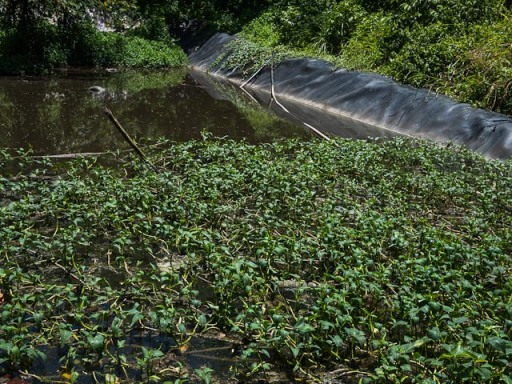Mmj 181
Landfill residents talk about their life in the dumps.
Garbage Juice: Effluence From Davao City’s Sanitary Landfill
“Garbage juice” is being served to some Davao City residents.
Environmental scientists discovered that Davao City’s sanitary landfill is a source of leachate, or toxic liquid that drains from collected garbage, into nearby water streams that feed into the Matina Pangi River. These toxins have likely spread downstream to communities in the Matina Pangi area.
The sanitary landfill is a 3.8-hectare facility about 15 kilometers away from downtown Davao. With a lifespan of eight to ten years, it is designed to accommodate 30% of the city’s 700 tons of daily garbage output until 2020.

Two scavengers dig into the immense pile of garbage that is Davao City’s sanitary landfill. In the background one can see the dark-colored synthetic liner meant to prevent leachate from seeping into the ground.
On August 24, 2011 a team from the Tropical Institute for Climate Studies’ (TropICS) of Ateneo de Davao University visited the landfill area to investigate the possible causes of Matina Pangi River’s overflowing to cause the flash flood that devastated communities in the Matina Pangi area two months previously.
Dr. Lourdes Simpol noticed a thin waxy coating on the surface of the river downstream from the landfill. She identified it as biofilm, a substance that poses a health risk to humans. It is known to cause a wide variety of microbial diseases, from urinary tract infection to gingivitis. Her team took note of children playing in the river and adults washing their dishes.
Engr. Dindo C. Corda, a staff member of the Pollution and Industrial Waste Management section of Davao’s City Environment and Natural Resources Office (CENRO), said that safety measures are built into the leachate pond.
“The effluence [from the garbage] goes through a series of treatments, chamber by chamber, where minerals are installed to clean the leachate. The treated liquid is then allowed [to flow into the creek].”
Asked if this type of fluid disposal has any harmful effect on the environment including people, he said, “So far there has been no complaint or report of contamination.”
Making a link between biofilm and the landfill, Dr. Simpol pointed to the leachate pond. The scientists saw that, despite the presence of a filtration system, the pond still spilled brown-colored water into the creek.

The water in the leachate pond is a stagnant brown liquid that environmental scientists suspect is toxic. Further tests need to be conducted to confirm this.
Glenn Depra, a team member, said that a landfill employee admitted to them that the pond’s filter was installed only after the flash flood. The scientists also discovered in a separate inquiry that the landfill management does not conduct water testing because they claim the resulting fluid is colorless.
Dr. Simpol stresses that theirs are just initial findings and that no further study has yet been done because their present research covers only the flash flood issue. But TropICS has been invited by CENRO to present these findings to them.
Depra is hopeful that this meeting will be a step closer to the improvement of Davao City’s waste management.
“I want to think that… by asking us… to help them in… the improvement of the landfill… then their intention is good,” he said.
Leave a comment